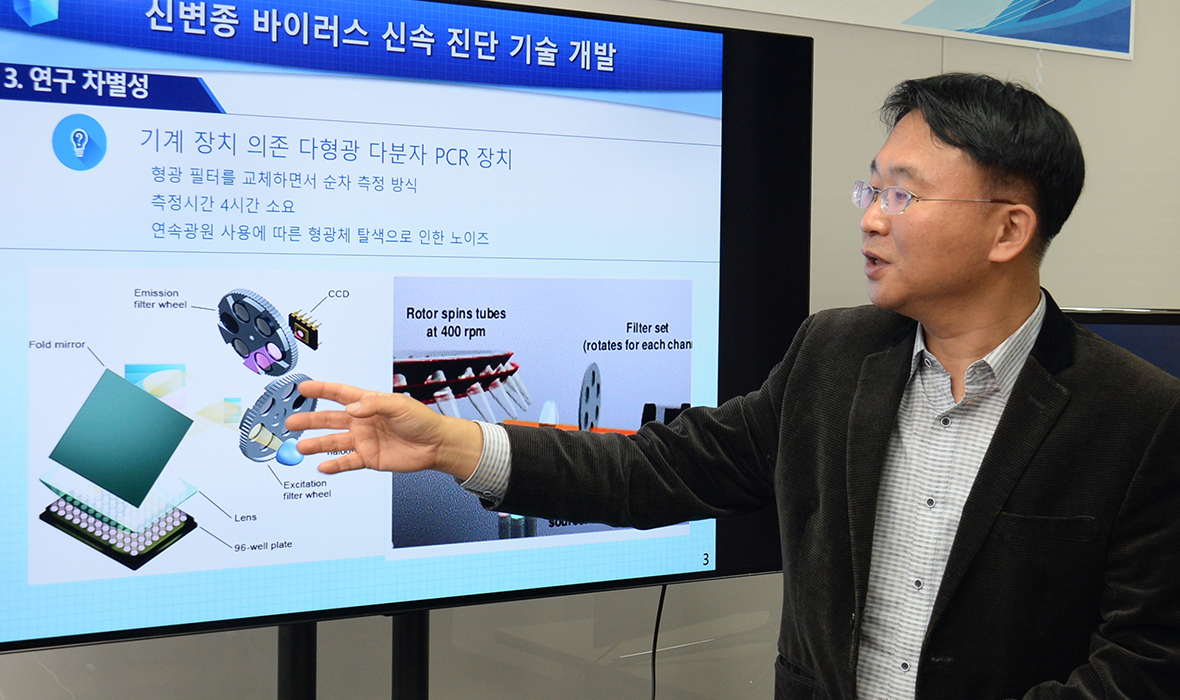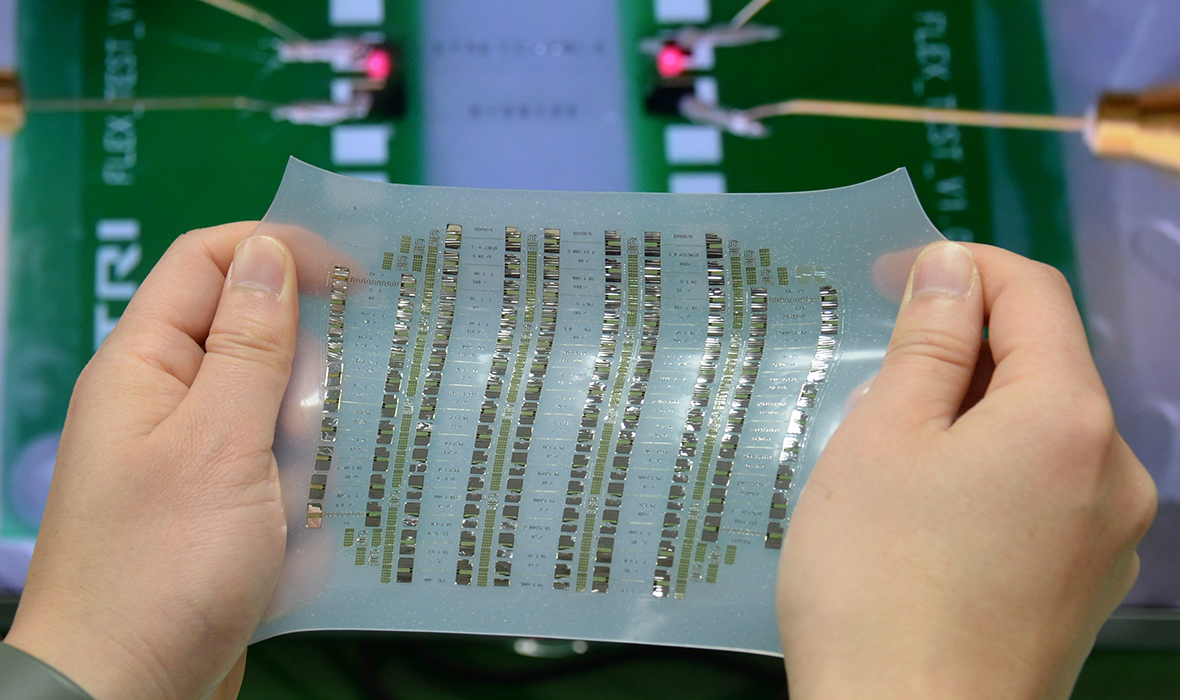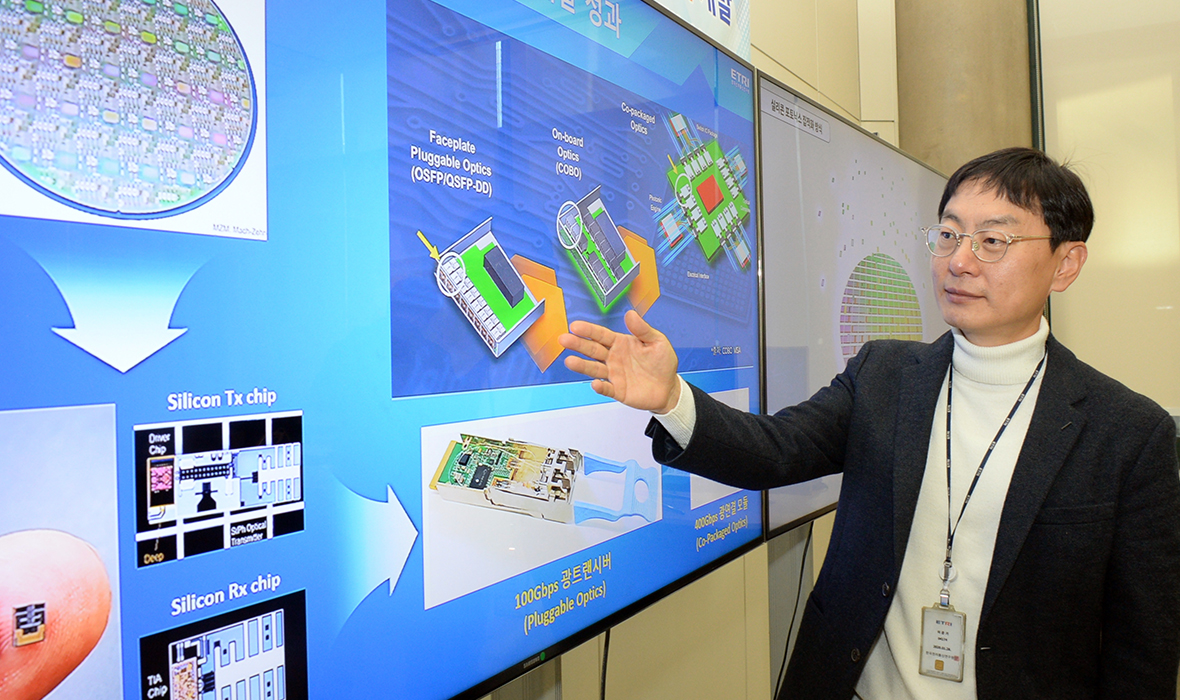
News
Vol.72
NEWS 1
Development of rapid simultaneous diagnostic technology for mutant viruses
- Development of a PCR device that measures up to 4 types of viruses simultaneously
- Multi-wavelength light source-based filter-free method, reduces inspection time to 40 minutes
※ Diagnostic & Therapeutic Systems Research Section, Digital Convergence Research Laboratory

Researchers in Korea have developed a PCR* device that can perform multiple RNA viruses and DNA analysis at the same time. The diagnosis time, which used to take more than an hour, is also expected to be shortened to less than 40 minutes to provide convenience for patients.
Electronics and Telecommunications Research Institute(ETRI) announced that it has developed a PCR device that can quickly test up to four types of viruses at the same time.
Existing devices required a number of color filters for multiple fluorescence measurements. Due to the complexity of the light source and camera configuration, the device is large and expensive. Measurement time is also long, about 2-3 hours.
The core technology of this development is code-based fluorescence signal separation technology. ETRI researchers removed the color filters and applied the orthogonal code-based signal processing technology, which is mainly used in wireless communication technology. It has also increased measurement reliability while implementing it inexpensively through a relatively simple optical device.
It is the principle of detecting the fluorescence signal of the virus gene by shooting light modulated with a specific code when measuring fluorescence. As genes are separated and amplified by PCR device, fluorescent substances are attached to the genes. When the fluorescent substances are irradiated with a modulated light source, a fluorescent light signal modulated with a code is generated.
The longer the code, it becomes possible to detect viruses with lower concentration, which is difficult to observe, and the noise is reduced. With high precision, four types of genes can be measured simultaneously, and when a sample has been prepared, a quick analysis of the genes can be done in about 40 minutes.
In particular, the method of measuring fluorescence using a specific code has the advantage of being able to diagnose with high accuracy regardless of virus mutation.
ETRI has applied for 6 domestic and foreign patents related to this technology, and plans to apply for 2 more in Korea and US patents in the future. For the commercialization of the technology, technology transfer is being promoted to biosensor and medical diagnostic device companies, and commercialization is expected to be possible at the same time as technology transfer.
* PCR (polymerase chain reaction): Polymerase chain reaction. Molecular biological technique to replicate/amplify desired part of DNA
Huh Chul, Director
Diagnostic & Therapeutic Systems Research Section
(+82-42-860-5306, chuh@etri.re.kr)
NEWS 2
Development of stretchable semiconductor device
- New concept electronic device design, 15 times higher integration-density, revealing the way to high resolution and miniaturization
- Easy mass production with standard semiconductor process, widening the gap in next-generation semiconductor technology
※ Flexible Electronics Research Section, Hyper-Reality Metaverse Research Laboratory

A research team in Korea has developed a stretchable inorganic semiconductor device technology to realize a stretchable display that can be stretched like a rubber band.
This achievement was published online on August 24 in the world-renowned scientific journal 'Nature Communications'. (free to access, https://www.nature.com/articles/s41467-022-32672-8)
A stretchable display is a next-generation display panel that can be stretched tightly and shortened like a rubber band.
In order to realize a high-resolution stretchable display with high usability, a high-performance stretchable semiconductor device is required.
The semiconductor device developed by ETRI has improved device integration-density(Number of device per unit area) by about 15 times compared to existing stretchable oxide semiconductor devices, and its current drive performance has also increased by more than two times.
In the past, the integration density was significantly limited due to an inefficient spatial structure in which stretchable metal wires and non-stretchable electronic elements were repeatedly connected, but this development is expected to achieve both flexibility and high-definition of the display panel.
The stretchable electronic device developed this time is highly compatible with the standard semiconductor process compared to previous methods that relied on specific techniques, and it can be applied to various stretchable products such as displays, smartphones, TVs, automobiles, healthcare, and skintronics, drawing particular attention.
In the future, the research team plans to focus on reducing costs by further simplifying the stretchable semiconductor process, and plans to prepare for rapid application to the industry.
Oh Himchan, Senior Researcher
Flexible Electronics Research Section
(+82-42-860-1442, fullchan@etri.re.kr)
NEWS 3
World-class metaverse performance technology is being developed
- The Ministry of Culture, Sports and Tourism is promoting the formation of a consultative body for five projects centered on the global virtual performance
- Contributing to the globalization of Korean Wave content such as K-POP and creating a new concept of virtual performance
※ Intelligent Reality Content Research Section, Hyper-Reality Metaverse Research Laboratory

Electronics and Telecommunications Research Institute(ETRI) has established a discussion group consisting of five R&D projects, including the 「Global Virtual Performance Core Technology Development Project」, to develop and implement world-class metaverse performance technology.
ETRI research teams have been developing core source technologies related to the metaverse through the projects such as the development of core technology for 5G-based VR/AR devices , the development of three-dimensional image technology for virtual content, the development of technology for creating AI designers and models, and the development of technology for immersive interactive content customized for virtual job training for people with developmental disabilities.
The goal of the research teams is to create a new concept of performance that communicates directly with the audience in the metaverse environment through the formation and operation of the consultation body for this linked project. In addition, it was decided to promote the development of the entertainment industry by developing a nationally representative virtual performance service in the field of performance contents.
A total of 22 institutions are participating in the development of technologies related to metaverse performances. Along with ETRI, eNgine Visual Wave Co., Ltd., Korea Electronics Technology Institute, Korea Institute of Industrial Technology, and LSware Co., Ltd. are responsible for five R&D projects, respectively.
The consultative body plans to develop the core technologies needed to implement the metaverse performance, such as performance platform technology, interactive audience avatar generation technology, virtual production technology, performing arts production collaboration platform, and digital music and video copyright protection technology.
ETRI plans to develop the technology to allow realistic experiences of metaverse performances by 2025 through ongoing collaboration in the consultative body. A demonstration service that will make tens of thousands of spectators feel as if they were at the actual performance site is scheduled to be conducted soon.
Gil Youn-Hee, Director
Intelligent Knowledge Content Research Section
(+82-42-860-1031, yhgil@etri.re.kr)
NEWS 4
Development of ultrahigh-speed optical input/output semiconductor using light
- Overcoming the limits of existing electrical connection, 100 Gbps performance and 20 % size reduction
- Expected to be used in next-generation data centers and high-performance computing due to low cost and miniaturization
※Optical Network Research Section, Terrestrial & Non-Terrestrial Integrated Telecommunications Research Laboratory

Electronics and Telecommunications Research Institute(ETRI) announced that it has developed a silicon photonics optical semiconductor chip and related modules that can transmit 100 Gbps of data per second in next-generation data centers and high-performance computing networks.
The size of the silicon optical transmitting chip developed by the research team is 2.9x7.3 mm, and that of the optical receiving chip is 2.9x3.4 mm. They are miniaturized by 20 % compared to the one based on the existing individual optical device assembly method.
Through this miniaturization, it is possible to solve the problem of limited communication input/output performance of electronic semiconductor chips, which arises with increasing data volume in data centers, high-performance computing, and AI networks. This can be achieved by integrating multiple optical devices into a single chip.
According to ETRI, it was able to make this accomplishment possible by using a world class high-performance silicon optical modulator that can transmit data at 100 Gbps per channel while consuming very little power, a photodetector with a distinctive structure that can operate at high speeds by boosting the electric field strength, as well as high-speed signal processing and signal integrity circuit design technology.
Optics Express, the most esteemed publication in the field of optical communication, published 5 papers in appreciation of its outstanding research, and it is a leader in optical semiconductor-related research with 35 domestic and foreign patent applications and 3 technology transfers.
In the future, the research team plans to carry out follow-up research to increase the speed per channel of the optical semiconductor chip to 200 Gbps and the transmission capacity to 1.6 Tbps, while reducing power consumption to less than half and size to about 1/9 or less of the existing ones.
Lee Joon Ki, Director
Optical Network Research Section
(+82-42-860-1659, juneki@etri.re.kr)